Leverage your brand’s website and social media platforms to connect and engage with your customers. Use our tips to optimize your digital marketing efforts while promoting your premium, platinum jewelry.
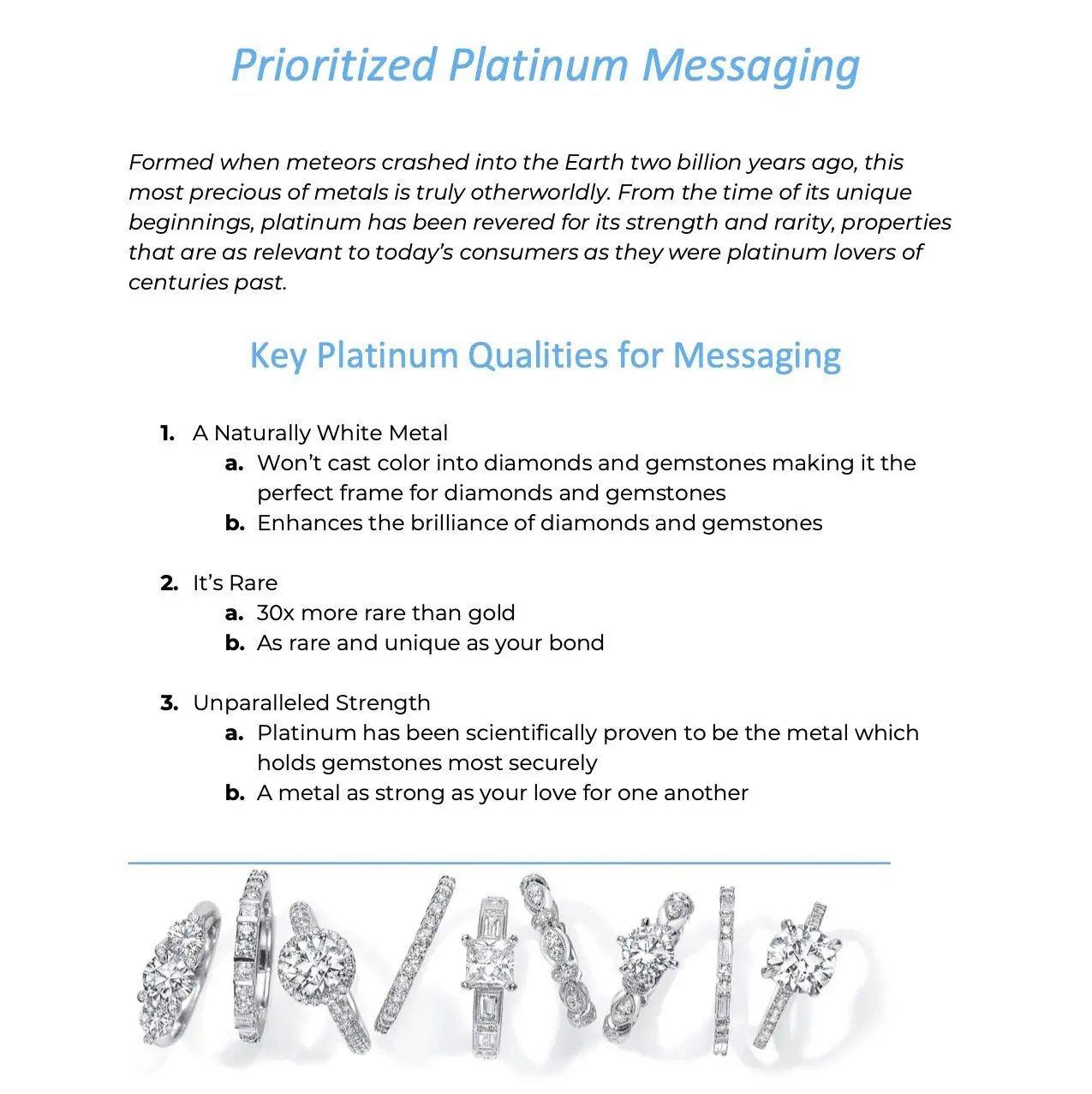

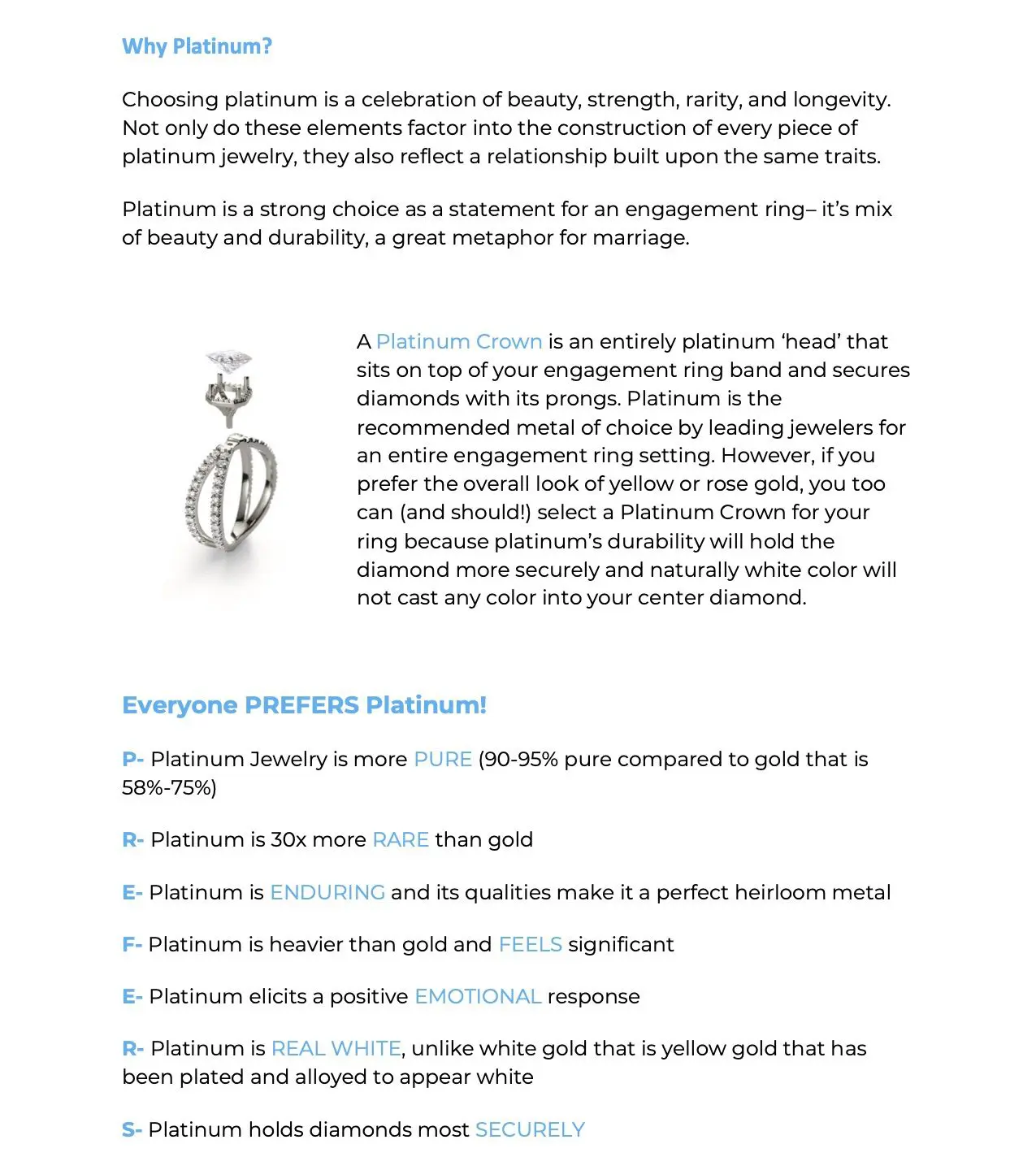
Fostering engagement on social media requires regularly sharing new content. Aim to post at least three times per week on each platform where you have a presence. Keep in mind that quality and consistency (e.g. sharing three strong posts every week) will be more effective than quantity (e.g. sharing three low-quality posts a day, when you remember to post).
Writing compelling copy: Think of post copy as very short story. Ensure that this story is interesting and makes the user want to click or engage with your brand in some way. Always find at least one opportunity to add value—teach the user something new, entertain her, or show off something exclusive. Use a voice that is reflective of your brand and be consistent post to post and platform to platform. Here are some examples:
Created in platinum to support your diamond, the [insert jewelry type, style and/or name] features _____________ set in platinum that will surely be cherished for generations to come.
Platinum’s natural white color perfectly complements your engagement ring’s diamond… it enhances the brilliance of the diamonds it surrounds, showing them off in their best possible light.
Platinum’s strength lets it stand the test of time, so it’s the perfect metal to protect your diamond through daily wear and tear, and symbolizes a relationship that will endure.
Choose platinum, a metal as strong and pure as your love for one another.
Choosing platinum is a strong choice as a statement for an engagement ring– its mix of beauty and durability is a great metaphor for marriage.
Hashtags help make your content discoverable by audiences who aren’t yet following your brand on Instagram. Remember to include #beplatinum in all of your platinum-related posts.
Reaching large audiences on Facebook and Instagram can be difficult, and even those who choose to follow your brand may not see every post. By boosting or promoting your posts you can ensure greater reach. Make sure you have your page set as a Business on Facebook/Instagram, and hit the “Boost” or “Promote” button on your individual posts to get started.
How to Host a Giveaway on Instagram
Social media giveaways can be a great way to increase your following, brand awareness, and consumer engagement in a very short time for a relatively low cost. This guide provided by PGIUSA is a helpful starting point for understanding social media giveaway best practices.

The Prize
Offer a prize that’s relevant to your brand and incentivizes entrants. Promote a platinum piece to show the quality your brand offers and to set it apart from competitors who don’t work with the world’s most precious metal. It’s important to curate multiple visuals of the prize so there is enough content to support the giveaway.
*Prizes that retail above $600 require the winner to provide the giveaway host with a completed W9 and signed affidavit prior to accepting the prize.

Promotion
Create a content calendar clearly outlining the visuals and related copy for all posts (in feed and stories) during the giveaway period.
It is recommended to start each Instagram giveaway with an anchor post in-feed that uses the most captivating image and the copy introduces the rules and requirements. Boost this anchor post with paid media to result in reaching a targeted audience wider than the existing follower base; it is recommended to spend a minimum of $100 on promotion.
Re-post your anchor post on stories, and ask related partners to share as well. PGI will support all platinum jewelry-related giveaways by sharing your brand’s anchor post on IG stories.

Timing and Conditions
An average of 3-5 days is the recommended giveaway length. Include a statement releasing Instagram from any responsibility. For example:
Open to U.S. residents only. Giveaway will be closed (time and end date). Winner will be drawn by (date) and notified via Direct Message. Per Instagram rules, this promotion is in no way sponsored, administered, or associated with Instagram. By entering, entrants confirm that they are 18+ years of age, release Instagram of responsibility, and agree to Instagram’s terms of use.
Fostering engagement on social media requires regularly sharing new content. Aim to post at least three times per week on each platform where you have a presence. Keep in mind that quality and consistency (e.g. sharing three strong posts every week) will be more effective than quantity (e.g. sharing three low-quality posts a day, when you remember to post).
Writing compelling copy: Think of post copy as very short story. Ensure that this story is interesting and makes the user want to click or engage with your brand in some way. Always find at least one opportunity to add value—teach the user something new, entertain her, or show off something exclusive. Use a voice that is reflective of your brand and be consistent post to post and platform to platform. Here are some examples:
Created in platinum to support your diamond, the [insert jewelry type, style and/or name] features _____________ set in platinum that will surely be cherished for generations to come.
Platinum’s natural white color perfectly complements your engagement ring’s diamond… it enhances the brilliance of the diamonds it surrounds, showing them off in their best possible light.
Platinum’s strength lets it stand the test of time, so it’s the perfect metal to protect your diamond through daily wear and tear, and symbolizes a relationship that will endure.
Choose platinum, a metal as strong and pure as your love for one another.
Choosing platinum is a strong choice as a statement for an engagement ring– its mix of beauty and durability is a great metaphor for marriage.
Hashtags help make your content discoverable by audiences who aren’t yet following your brand on Instagram. Remember to include #beplatinum in all of your platinum-related posts.
Reaching large audiences on Facebook and Instagram can be difficult, and even those who choose to follow your brand may not see every post. By boosting or promoting your posts you can ensure greater reach. Make sure you have your page set as a Business on Facebook/Instagram, and hit the “Boost” or “Promote” button on your individual posts to get started.
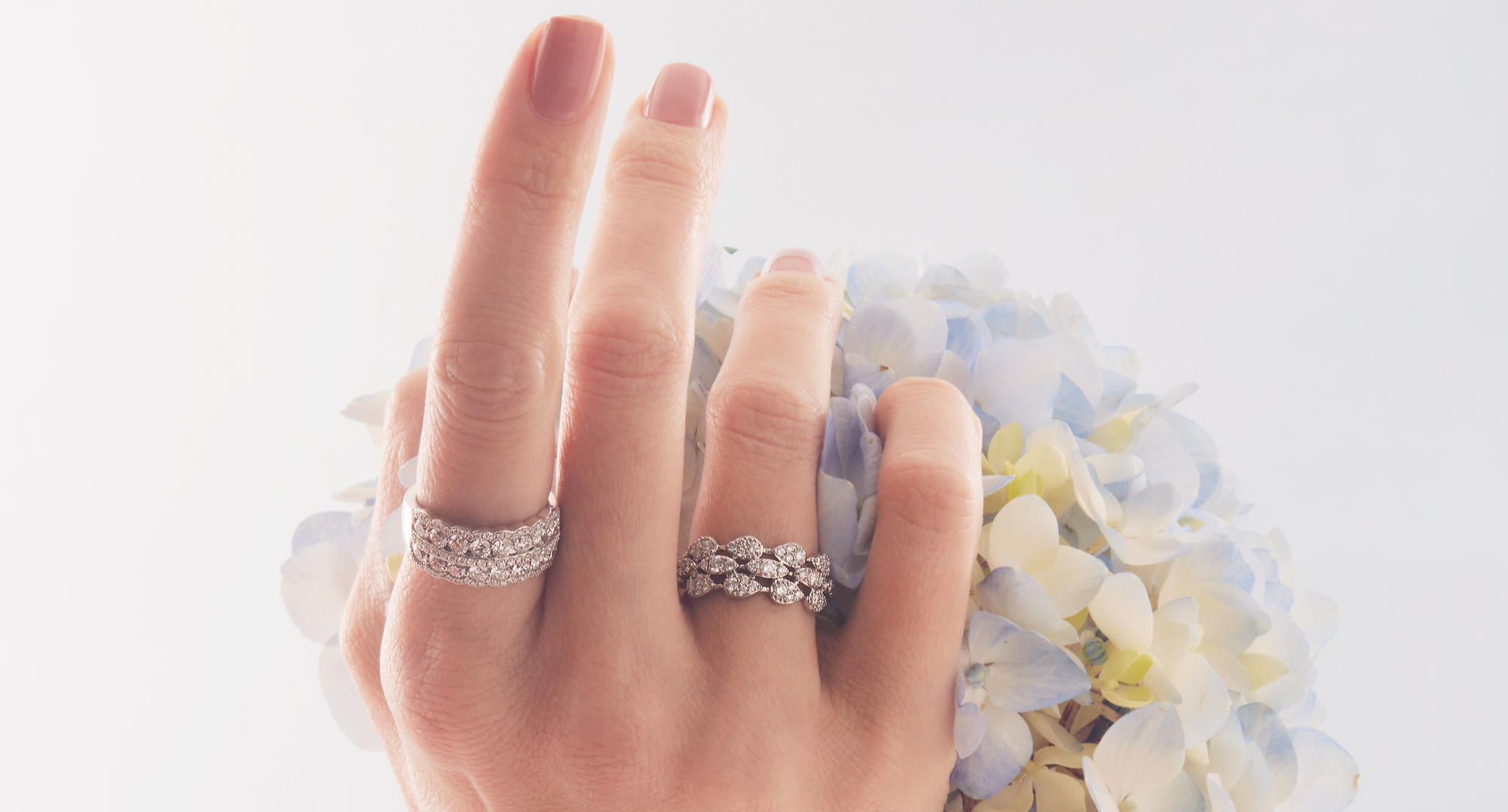
Creating Social Content Anywhere
Part l: Still Life Product Shots
Consumers are active on social media now more than ever, making it crucial for your store to maintain an active online presence. While your business is disrupted, it may seem like a difficult time to create content. However, there are many simple ways to get creative from home and strengthen your customer relationships and brand image through social media content. In this new series, PGI USA will offer tips and best practices for creating engaging social content from the safety of your home. Please see below for the first edition, which offers recommendations on creating eye-catching product shots for social media.
STILL LIFE PRODUCT SHOTS
Although consumers currently have ample time to scroll through their social apps, there’s also an overwhelming amount of content to view. Curating interesting and attractive imagery is essential to standing out in a saturated landscape.

Avoid Plain Product Shots
Simple product photography on a white background is great for your Ecomm site, but can easily be overlooked on social.
Consider combining multiple pieces in one shot and playing with the layouts and angles. Keep in mind that odd numbers are usually most appealing, and you should experiment with non-centered shots while keeping the main product the image’s focus.
Props can also be very useful in creating an interesting composition. Look around your house! Try laying your jewelry on different fabrics and surfaces and utilizing household objects.
– Fabrics include suede, velvet, or a kitchen towel with a fun print.
– Surfaces such as a marble, a wood cutting board or a nice wooden table can make for a great image background.
– Objects found around the home like shoes, china, drinkware + accessories can help your photos tell a story.

No Camera? No Problem! If you don’t have a high quality digital camera on hand, that doesn’t mean you can’t take beautiful product images! Today’s smartphones are capable of taking excellent photos – especially for social media. When you find a look that aligns with your brand, try to emulate these settings on your future photos to create a cohesive-looking social feed. Follow these recommendations:
– Natural light: Head to your closest window on a sunny day and capture the natural light. Even overcast days can produce great natural light.
– All hands on deck: If you have another person at home with you, or a non-dominant hand available, take the opportunity to show off your jewelry on someone. Find a pose that feels natural and try out some light movement in a video. Don’t forget to lotion hands and clean up nails first!
– Camera settings: Be sure to play around with Portrait mode if you have that capability.
– Have fun: Experiment with various light options and shadows to see what you can create. If you find a look you like, try to emulate these settings with your future photos.
SIZING RECOMMENDATIONS
– Instagram and Facebook feed post (photo or video): 1080×1080 for a 1:1 ratio or 1080×1350 for a 4:5 ratio
– Instagram story (photo or video): 1080×1920 for the 9:16 ratio *try not to post too much larger, as Instagram may compress your file for display and lose quality.
– Facebook cover: the same photo will crop to 820×312 for desktop and 640×360 for mobile, so keep a safety zone in the middle of 640×312
– Pinterest: 1000×1500 for a 2:3 ratio, ideal to not cut off in people’s feeds
– Profile images: 1:1 ratios for Pinterest, Facebook, and Instagram, keeping in mind that the programs will crop the image to a circle

A light box is a great investment if you’re planning to take your own photos. The LED light contained within the reflective interior of the tent or box allows you to achieve a very high-quality look to your jewelry shots, even if they’re taken with a phone. This Studio-in-a-Box from B&H Photo is a great option to get started.
If you’re not able to get a light box, a plain piece of foam board can help create an environment with a horizon line and a wall/corner. For shots on yourself or another person, a ring light may also be a good investment.
Fostering engagement on social media requires regularly sharing new content. Aim to post at least three times per week on each platform where you have a presence. Keep in mind that quality and consistency (e.g. sharing three strong posts every week) will be more effective than quantity (e.g. sharing three low-quality posts a day, when you remember to post).
Writing compelling copy: Think of post copy as very short story. Ensure that this story is interesting and makes the user want to click or engage with your brand in some way. Always find at least one opportunity to add value—teach the user something new, entertain her, or show off something exclusive. Use a voice that is reflective of your brand and be consistent post to post and platform to platform. Here are some examples:
Created in platinum to support your diamond, the [insert jewelry type, style and/or name] features _____________ set in platinum that will surely be cherished for generations to come.
Platinum’s natural white color perfectly complements your engagement ring’s diamond… it enhances the brilliance of the diamonds it surrounds, showing them off in their best possible light.
Platinum’s strength lets it stand the test of time, so it’s the perfect metal to protect your diamond through daily wear and tear, and symbolizes a relationship that will endure.
Choose platinum, a metal as strong and pure as your love for one another.
Choosing platinum is a strong choice as a statement for an engagement ring– its mix of beauty and durability is a great metaphor for marriage.
Hashtags help make your content discoverable by audiences who aren’t yet following your brand on Instagram. Remember to include #beplatinum in all of your platinum-related posts.
Reaching large audiences on Facebook and Instagram can be difficult, and even those who choose to follow your brand may not see every post. By boosting or promoting your posts you can ensure greater reach. Make sure you have your page set as a Business on Facebook/Instagram, and hit the “Boost” or “Promote” button on your individual posts to get started.

SHORT & SWEET
Making your own social media videos can be surprisingly simple, and it’s a great opportunity to connect with your audience in a new way.

AUDIO REMINDER
Audio is often an afterthought but plays a very important role in overall video quality. If audio is being recorded make sure to find a quiet place away from other sources of noise (street traffic, others speaking, loud air-conditioner).

NO CAMERA? NO PROBLEM
Today’s smart phones are perfectly capable of taking quality video- especially for social media. If you’d prefer to do multiple takes over just one, you can edit these together with free programs such as iMovie.

COMPOSITION & FOCUS
It’s good to know the specs for the social media platform that will be used to post these videos. Keep in mind composition (what is in frame or viewed) and what you are focused on within the shot.

LIGHTING IS KEY
For jewelry to look its best on screen, it’s important to have the best lighting possible. For close-up product shots, try filming by a window for natural light, or setting up lights to illuminate the product and show its shine. Be mindful of any harsh shadows the lighting creates. Harsh shadows can be visually distracting and unpleasant in a video or photos.

HAVE FUN WITH IT!
These videos are most engaging to watch when the person is enthusiastic about the jewelry and clearly enjoying themselves. Let your personality shine through, and show customers what a positive experience they’ll have if they stop in to your store.
Part l: Social Media Insights
Understanding your audience and its behavior is essential to being able to reach it and advertise effectively. Be sure to utilize the analytics function found on social media platforms and websites to better understand how your audience behaves and to ensure a strategic marketing approach.
Social Media Insights
For business accounts, social media platforms track audience information (demographics and activity) which provides a business with invaluable insights on how its audience interacts with its content. It is important to confirm that you have a Business Profile set up on Instagram and a Business Page set up on Facebook to allow for these free analytics.
Instagram Insights
Access your insights by clicking the menu bar on the top right of your profile, and then choose the “Insights” option. On that page you will be able to view the following information:
Content Tab: See all of your posts (up to two years) and stories (up to 14 days) and how they performed. Older stories and their metrics can be saved in your archive by marking ‘Save to Archive’ in story settings. The best measurement of your posts’ successes is interactions (likes, comments, saves, and shares). Even better: look at the engagement rate (calculated by dividing interactions by post impressions) to analyze which types of posts perform better, and to compare the effects of your different efforts over time.

Activity Tab: View your account’s recent reach, impressions, profile visits, and website clicks from the last seven days compared to the previous seven days. You can see how your account has performed over the most recent week, and line that up against other promotional efforts (ex: if you were featured in a blogger’s post then you would want to see if that mention resulted in a peak in activity compared to the week prior without any external influence).
Audience Tab: Track the growth of your follower base. In this section, you are able to learn about your audience’s demographics (location, age, gender) which can (A) help you tailor your content to better resonate with your audience, or (B) alert you to the need to refine your strategy if you are attracting an audience that does not align with your business objectives. This tab also shares follower activity based on time of day with relation to each day of the week which can help you determine the best day/time combination to post.
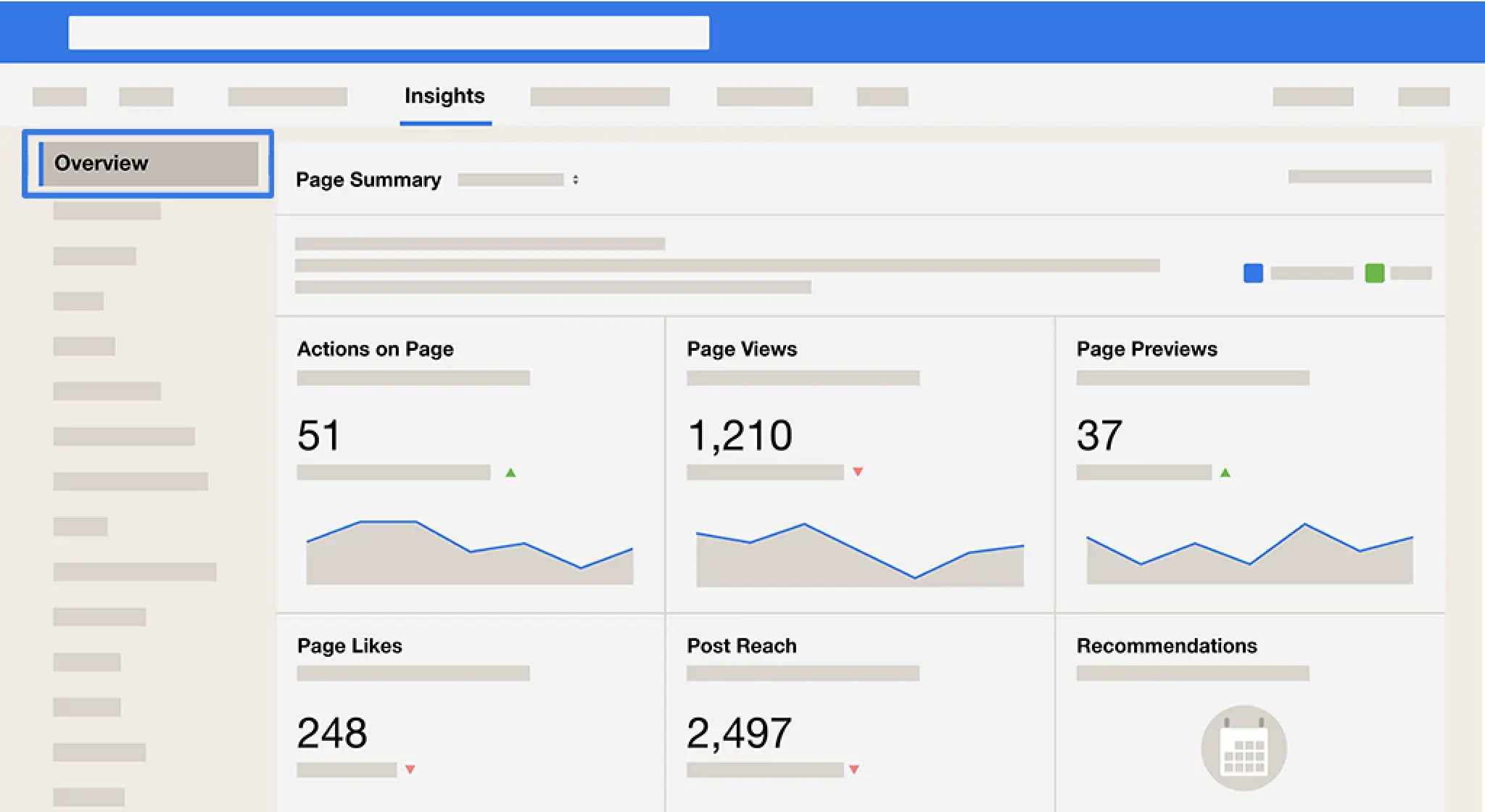
Facebook Insights
Facebook Page Analytics can be found by clicking the “Insights” tab on the top of your page.
 Image via Facebook
Image via Facebook
The Overview: Under the Insights tab, select “The Overview” to find important, top-level page metrics (see key terms defined below) that can give you insight into how your page is performing and how your audience is interacting with it. Under this section, you will find updates like number of new likes, followers, page views, and post engagement, as well as be able to track your responsiveness and recommendations (when users recommend your business to their followers).
Posts: In the Posts section, you can view a graph of “When Your Fans are Online,” averaged over a time period of your choice. This is very helpful for deciding when to post. You can also see your Post Types, which is an aggregate view of how well different types of posts perform with your audience. These tools can support future content creation to better resonate with your audience. Under All Posts Published, you can view the following information on all of your past posts:
- Type: Link, photo, video, etc.
- Targeting: See if a specific audience was targeted and if it was a public post.
- Reach: The number of people who saw your post. Hold your mouse over the yellow bar to view a breakdown of paid vs. organic reach.
People: This section shares a demographic breakdown of the people visiting your page. In Actions on Page, you can see who clicked on your contact information or website… broken down by age and gender, country, city, and device. More detailed audience information can be found on Facebook’s Audience Insights tool.
 Image via Facebook
Image via Facebook
Recommendations:
- Based on your insights, create a content calendar to schedule your posts on the days and times when your audience is most active.
- Check in often: this data updates constantly, so you’ll want to analyze it often to look for patterns and trends. You can also click “Export Data” at the top right of your Overview tab on Facebook to download your page data.
- Respond to messages and comments as quickly as possible. This builds trust by showing you’re attentive and engaged.
- If your audience demographic doesn’t align with your ideal customer, consider targeting your posts toward a more specific audience. Try different promotion strategies and track your insights to see the response.
Important Terms to Know
- Website Clicks: Number of users who have clicked on the link in your Instagram bio.
- Profile Visits: Number of users who have visited your Instagram profile.
- Actions on Page: Number of combined clicks on your contact information and call-to-action button.
- Page Views: Total views of your Facebook Page.
- Page Previews: Number of times users held their mouse over your Page information to see a preview of your Page.
- Post Reach: Number of unique users who saw your posts.
- Post Impressions: Total number of times your post was seen.
- Post Engagement: Combined total of post likes, comments, shares, and other engagements.
- Responsiveness: Evaluation of how often and how fast you respond to messages.
Social media is an effective way to reach a large population and define your brand, but it doesn’t exist alone. Social can support or amplify your other efforts, and it’s important to create an integrated strategy across all of your platforms.
Part ll: Web Analytics
Understanding your audience and its behavior is essential to being able to reach it and advertise to it effectively. We shared in a previous enewsletter the best practices for leveraging analytics on your social media platforms, and now want to review the importance of understanding visitor behavior on your websites. With a stronger shift to an omnichannel world, it is imperative you strengthen the digital side of your business to ensure a strategic marketing approach.
WEB ANALYTICS
Tracking analytics for your website is essential to understanding the demographics and behavior of your audience and to then build an effective marketing and communications strategy. It’s highly recommended to link your site with Google Analytics, a free website analytics service that can provide you with very detailed reports. Read our introductory guide below for tips on how to begin tracking with Google Analytics and the key data to examine, including audience information and behavior.
First, make sure you have a Google Analytics account set up. Go to analytics.google.com, and sign in, or click “Set Up For Free.” Then, follow the instructions to set up a property within your analytics account, which is the collection point of data from your website. Follow the steps to add the tracking code to your website. Later, you can modify this tracking code to collect additional data.
Tip: The platform you use to manage your site may offer a simple plugin that makes code installation a breeze.
For e-comm sites, it’s very important to properly enable ecommerce, and ideally advanced ecommerce reporting as well. This will often require a developer to be done correctly.
Your Google Analytics Homepage
On your Homepage, you’ll see an overview of key statistics over a recent time period of your choice (default is 7 days) as well as a real-time report of current active users. Note any significant changes in users, revenue, and sessions. Scroll down on your homepage to see other key data such as:
• How you acquire users
• Where your users are geographically
• When users visit (frequency based on day & time)
• Top pages visited
• What devices visitors are using
• User retention (week by week)
• Top-selling products (if applicable)
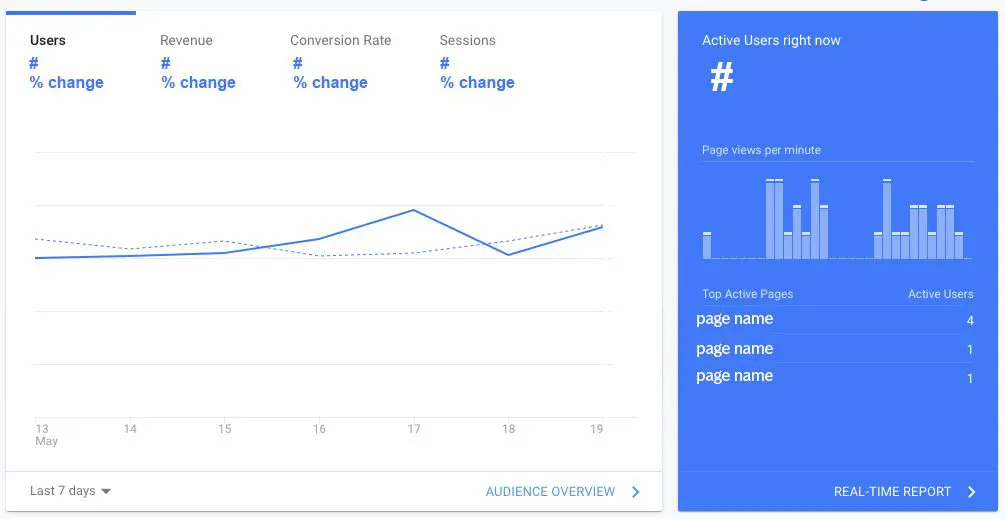
Available Reports on Google Analytics
On the menu on the lefthand side of your Analytics platform, you’ll see a list of Reports you can view. This is where you’ll find extensive, constantly updating reports on your site’s data. There are many subcategories containing more detail- a great way to start is by exploring these different reports and categories. Google provides definitions for many of terms that may be unfamiliar, if you roll your cursor over the “question mark” beside them. You can create additional custom reports, but the four key categories are below:
Real-Time Reports provide a current overview of users on your site, including location, traffic source, content/pageviews, and conversion.
Acquisition Reports are very important because it shows you how people are arriving to your website. This allows you to judge the effectiveness of efforts such as emails, social promotion, ad campaigns, and search. If you find certain channels drive a lot of site traffic, you can spend more time and effort on these in the future.
Behavior Reports provide information on user behavior, including page views, amount of time spent on different pages, searches performed, site speed, and behavior flow. Understanding how your audience moves through your website is great insight into their thought process and can help you design a better user experience.
Conversion Reports show conversion rates and product performance information like add-to-carts. A conversion is when a session reaches its goal, such as an online purchase. Conversion rates represent the number of visitors who complete the desired action, calculated by dividing the number of conversions by the total number of visits. This report is very useful for e-commerce sites.
Enhance Your Knowledge
Google Analytics contains a vast amount of information that can feel overwhelming to navigate at first. To get the most out of your analytics, you can take free online courses on the Google Analytics Academy.


Utilize these resources to learn more about platinum’s technical properties.
Professional bench jewelers understand from hands-on experience the complexities of a metal’s technical properties and how they affect its wear in jewelry. As part of a platinum wear resistance study with the fem Research Institute for Precious Metals and TechForm Advanced Casting Technology, we asked skilled bench jewelers Jo Haemer (of Gentry Goldsmithing), Timothy Green (of Timothy W Green Fine Jewelry) and Dyke Vandenburgh (of Dyke Vandenburgh Jewelers) to speak about their experiences working with platinum over the years.
Experienced jewelers explain how platinum jewelry wears over time and never loses its integrity.
The bench jewelers discuss how platinum does not corrode from chemicals such as chlorine and bleach, like many gold and silver alloys do.
Jewelers explain why they recommend platinum crowns to most securely hold precious stones, even if the band of the ring is in another metal like gold.



